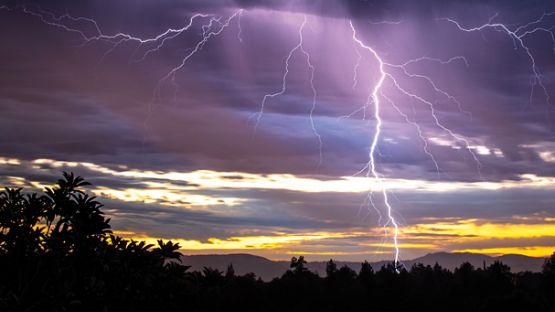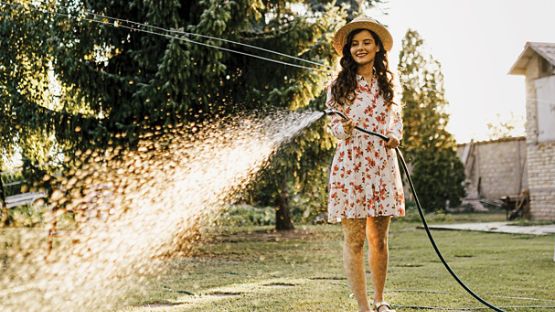Canada is known for its breathtaking landscapes. From coast to coast, there’s no shortage of picture-worthy forests and grassland areas, including wetlands and parks. While lush greenery adds to Canada’s scenic beauty, it also increases its vulnerability to wildfires (or wildland fires), particularly during the warmer and drier months from May to September.2 Depending on the geographic location and climate, wildfire season may start earlier in some parts of Canada. If you live in or near wildfire-prone areas, there are practical actions you can take to help prevent and mitigate fire damage should it find a way towards your home.
Did you know?
Wildland fires recycle nutrients, help plants reproduce, and create a mosaic of vegetation that provide habitats for a variety of wildlife.3
Protect yourself and your property from wildfire
Wildfires can start unexpectedly and can spread quickly across dry foliage and grass. Living in areas that are rich in natural vegetation may put you in the direct path of a wildfire. Burning debris can ignite things around your home like wooden fences, wood or vinyl siding, wood piles, dried leaves and grass. Dense smoke from wildfires can also travel many kilometres and affect other urban areas.
How wildfires typically spread to your home2
All it takes is ignition, fuel, and dry weather to start a fire. Ignition can either be a flash of lightning or can be human-caused.
Embers and sparks
Embers and sparks can drift up to 2 kilometres and ignite materials on or near your home causing fire damage.
Extreme heat
Radiant heat from a fire can melt vinyl siding, break windows, and even ignite your home. Flames within 30 metres of your home can cause extreme heat.
Direct flame
As wildfires spread toward homes, they can ignite other objects along the path. To stop the fire from directly affecting your home, create gaps in the path, especially near your home.
Find out how resilient your home and property are to wildland fire
Check if your home is wildfire-ready in minutes.
Don’t let wildfires catch you off-guard. Have a plan and be prepared before wildfire season rolls around so everyone in your household is ready. Make wildfire prevention and mitigation a top priority.
Before a wildfire
Be wildfire prepared
When it comes to wildfires and smoke events, calls for evacuation can come at a moment’s notice. Being prepared for an emergency before an evacuation order is essential. Here are some things you can do ahead of time:
Enhance safety at home and help prevent losses
Maintain areas around your property such as removing dried branches, leaves, debris and any combustible items.
Store firewood and propane tanks away from the home.
Keep grass to a height of 10 cm or less.
Use decorative gravel instead of mulch for garden beds.
Plant fire-resistant plants and keep them well-watered.
Cover exterior vents with 3mm screening to prevent embers from entering the home.
Review your home insurance policy with your insurance representative to ensure you have appropriate coverage and understand how to report losses in the event of a wildfire.
Explore more tips to FireSmart your home and what you can do before a wildfire.

During a wildfire

Stay safe during a wildfire
Wildfire and smoke events can change quickly. Here are some things to consider so you can respond quickly:
Be alert and informed
Know the potential wildfire and/or smoke risks in your area, and stay informed of the latest alerts and calls for evacuation from your local government.
Monitor the wildfire’s progress from trusted local radio and news stations or follow local authority social media accounts for the status of the wildfire and/or smoke event and possible road closures.
Consider installing your provincial emergency alert application (if available) to your cellphone.
Bring your 72-hour emergency kit and other essential items if an evacuation is issued.
Take proactive measures as a wildfire approaches your home
If it’s safe to do so, consider the following actions:
Close all windows, doors and vents of your home to prevent embers or smoke from entering.
Turn off propane or natural gas and move combustibles (like firewood) away from the home.
Wet down areas surrounding structures, including shrubs may help reduce fuel available for ignition.
Be prepared to evacuate your home at any time in case of a fire emergency if told to do so by authorities.
Read more on Canadian wildfires.

After a wildfire
Recover after a wildfire
It can be overwhelming to return home after a wildfire event. Take care of yourself and take it one step at a time.
Prepare to return home after a wildfire
Wait for the green light from authorities before returning to your community.
Be aware of your surroundings as roads and walkways may be littered with debris from the fire.
Work with authorities to ensure your home is structurally sound to return home.
If it’s safe, take photos to document any damages and keep an inventory of belongings you may need to replace. Detailed information about any wildfire damage may help expedite a claim.
If you suffered a loss, when it’s safe, call your insurance representative as soon as possible to submit a claim. Or, if available, you can also file a claim online.
Read more on what to do before, during and after a wildfire.

Looking for more tips to prepare for extreme weather?
Whatever the season be prepared and take precautions early to help ensure the safety of your family and property.
Related articles

Safe from the flame: The cause and cost of wildfires
How we can remain safe from the flame, with the right vigilance and diligence.

Safe from the flame: How to survive a wildfire
Learn how to prepare yourself, stay safe, or recover from a wildfire.

Safe from the flame: How to protect your home from wildfires
Get peace of mind knowing your home is wildfire-ready with a little time, effort and planning.
Sources:
1 Institute for Catastrophic Loss Reduction
2 Government of Canada: Get Prepared
3 FireSmart Canada: Begins at home guide
4 Canadian Red Cross: Wildfires
The content in this article is for information purposes only and is not intended to be relied upon as specific professional or expert advice. Aviva Canada accepts no responsibility for action taken as a result of reliance on any information contained on this webpage. Aviva and the Aviva logo are trademarks used under license from the licensor.

